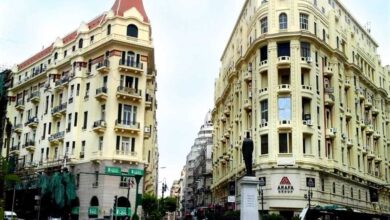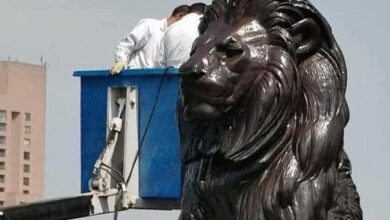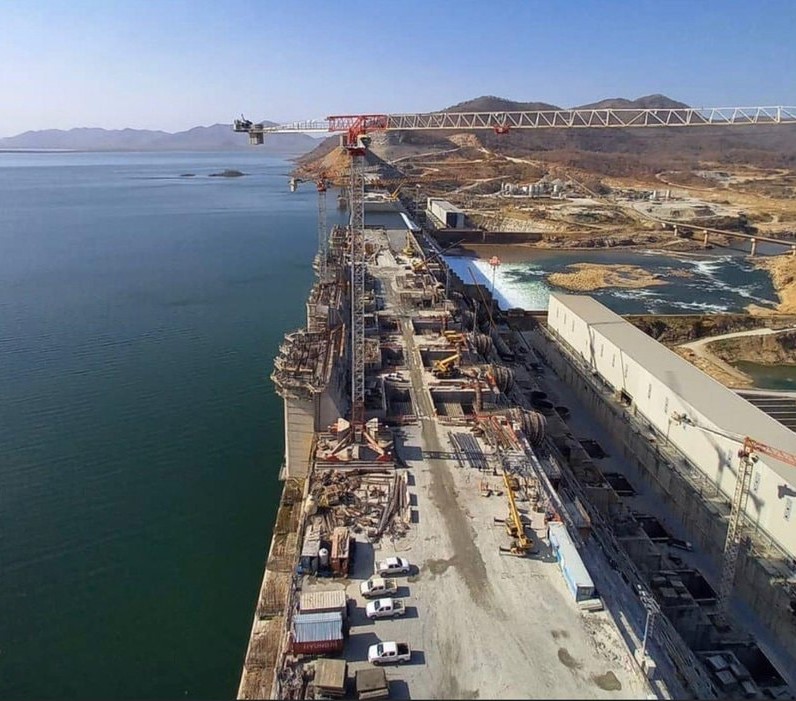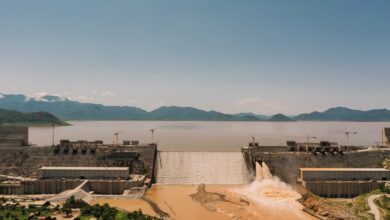Tahrir Square is more of a center point in Cairo than it ever was before. On the weekends, people gather around the square to speak and listen – working out the problems the country faces today. At least six streets pass through Tahrir Square, one of which is Tahrir Street, which passes over Qasr al-Nil Bridge, briefly cuts across part of Gezira/Zamalek, and then heads into Dokki, becoming a chaotic main road with landmarks like Cinema al-Tahrir.
Leaving the busy downtown life via Tahrir Street makes you feel like turning your back on simple everyday life and walking toward something bigger. You can leave the hectic activities at Tahrir Square through several streets, but escaping on Tahrir Street just feels right. Wide, open and light as it is, it seems the street itself is inviting you to take it.
Over the Nile, Qasr al-Nil Bridge is guarded by four large lions, the work of French sculptor Henri Jacquemart, one on each side of the road and of the bridge. And although it seems like their only function today is to pose in the background while young people have their pictures taken or bear the brunt of political and personal messages through graffiti, it seems unquestionable that at some point in history, their grandeur served a better purpose.
“I have so many memories from this place,” a young revolutionary says, while passing over the Qasr al-Nil. As wide and open as the street is crossing the Nile it is also claustrophobic, because there’s nowhere to go but back and forth.
“We were coming from here, the police from there,” he says, talking about 28 January, “We tried to get to the square, but the police were using teargas and even fired shots. In the end there was nothing we could do but to run back. There was nowhere else to run.”
Most people at first seem to pay little attention to the horrors that once happened on this exact spot. They hold hands, they paint the railing, they offer taxi rides. Life goes on. Perennially guarded by lions, you leave the bridge and walk out onto Gezira, where a statue of Saad Zaghloul greets you.
Not certain of what to expect at the end of the road, you pass Gezira with the green park surrounding the Mohamed Mukhtar Museum at your left and the Opera building on your right. The whole area around you on both sides of the street is made only for you to enjoy the scenery while walking toward wherever the street is leading you to. Leaving the island of Gezira you pass by the statue of Poet Laureate Ahmed Shawky by sculptor Sayed Abdou Selim, passing the Nile once again on Tahrir Bridge on the way to Midan al-Galaa.
And then something strange happens. After leaving Midan al-Galaa, the magic of Tahrir Street suddenly disappears and suddenly, more than anything, it just looks like a hectic main road with advertising signs instead of monuments and tall buildings instead of green areas. Gone is the romantic look on the faces of young people outside the park and the wind that forced you to clear your mind when you were passing the Nile.
No lions or statues are reminding you of the history of the country you’re walking around in. Instead you’re surrounded by cars and minibuses, women who sell tissues and men who offer to polish your shoes. Ahwas with men sitting in plastic chairs smoking shisha and small shops offering you anything from freshly baked pastry to plumbing articles. Surprisingly similar to the scenario you left in downtown in fact. And you think to yourself: is that really it? Did I walk along those wide streets and pass those majestic Midans just to experience another downtown?
Not at all, if you ask Mohamed Khalil a shop owner on the street.
“The city is much quieter here than in other places in Cairo. There are many cars everywhere, but they’re not as noisy here as downtown,” he says. According to Khalil, Tahrir Street has always been this busy. Khalil has had shops in different places along the street for 15 years now and doesn’t remember the street having been any different than it is now.
“There has always been a lot of traffic here and it has always been noisy,” he says.
“This is a big street,” he says. “It can take you anywhere. The people in the cars are coming from all sorts of places and going to all sorts of places. I like that,” he says.
Tahy Arf, an employee in one of the shops on the street, also enjoys how the street is filled with people from different areas of the world.
“People from so many different nationalities walk this road,” he says. “I think that makes the street an interesting place.”
Arf is able to watch the street life from his shop during the day, and even though the heavy traffic brings in a lot of different and interesting things, it has a dark side as well.
“There are a lot of car accidents on this road,” he says. “Each day I see two or three accidents.”
And that’s what happens on Tahrir Street after Midan al-Galaa. At this point the street no longer gives you the impression of leading you to somewhere, but only keeps you from crossing to the other side of the street. It no longer opens your world, but limits it. However, if you regret ending up here you can always take the metro back downtown.




